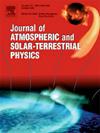基于单窗算法和机器学习方法的Landsat 8地表温度反演评估与改进
IF 1.9
4区 地球科学
Q3 GEOCHEMISTRY & GEOPHYSICS
Journal of Atmospheric and Solar-Terrestrial Physics
Pub Date : 2025-09-03
DOI:10.1016/j.jastp.2025.106618
引用次数: 0
摘要
马来西亚巴生谷等城市地区日益受到快速城市化和气候变化驱动的地表温度上升的影响。准确的地表温度反演对环境监测、气候分析和城市热岛研究至关重要。然而,在验证卫星获得的地表温度与地面测量的对比方面仍然存在挑战,特别是在云层频繁覆盖的热带地区。本研究旨在利用单窗口算法(MWA)对Landsat 8和9操作陆地成像仪/热红外传感器(OLI/TIRS) 2015年至2022年的热红外数据进行地表温度检索。选择云量小于40%的图像以确保数据质量。检索到的LST值与马来西亚气象局(METMalaysia)在几个地面站获得的气温数据集进行了验证。为了提高预测精度,对回归树精细树(Fine Tree of regression Trees)、精细高斯支持向量机(Fine Gaussian Support Vector machine, SVM)和广义神经网络(Wide Neural Network, NN)等机器学习回归模型进行了测试。采用均方根误差(RMSE)、平均绝对误差(MAE)和决定系数(R2)对模型性能进行评价。Fine Tree of Regression Trees模型的准确率最高,RMSE为0.8876°C, MAE为0.7878°C, R2为0.7011。这些发现证明了将MWA与机器学习结合起来进行可靠的LST估计的潜力,并突出了其在环境和城市气候分析研究中的适用性。本文章由计算机程序翻译,如有差异,请以英文原文为准。
Assessment and enhancement of Landsat 8 land surface temperature retrieval using mono window algorithm and machine learning approaches
Urban regions such as Klang Valley in Malaysia are increasingly affected by rising Land Surface Temperatures (LST) driven by rapid urbanization and climate change. Accurate LST retrieval is essential for environmental monitoring, climate analysis, and urban heat island studies. However, the challenges remain in validating satellite-derived LST against ground-based measurements, particularly in tropical regions with frequent cloud cover. This study aims to retrieve LST using the Mono Window Algorithm (MWA) applied to the thermal infrared data from Landsat 8 and 9 Operational Land Imager/Thermal Infrared Sensor (OLI/TIRS) imagery from 2015 to 2022. Selected images with less than 40 % cloud cover were used to ensure data quality. The retrieved LST values were validated against the air temperature dataset obtained from the Malaysian Meteorological Department (METMalaysia) at several ground stations. To enhance prediction accuracy, machine learning regression models including Fine Tree of Regression Trees, Fine Gaussian Support Vector Machine (SVM), and Wide Neural Network (NN) were tested. Model performance was evaluated using Root Mean Square Error (RMSE), Mean Absolute Error (MAE), and Coefficient of Determination (R2). The Fine Tree of Regression Trees model achieved the highest accuracy, with RMSE of 0.8876 °C, MAE of 0.7878 °C, and R2 of 0.7011. These findings demonstrate the potential of combining MWA with machine learning for reliable LST estimation and highlight its applicability in environmental and urban climate analysis research.
求助全文
通过发布文献求助,成功后即可免费获取论文全文。
去求助
来源期刊

Journal of Atmospheric and Solar-Terrestrial Physics
地学-地球化学与地球物理
CiteScore
4.10
自引率
5.30%
发文量
95
审稿时长
6 months
期刊介绍:
The Journal of Atmospheric and Solar-Terrestrial Physics (JASTP) is an international journal concerned with the inter-disciplinary science of the Earth''s atmospheric and space environment, especially the highly varied and highly variable physical phenomena that occur in this natural laboratory and the processes that couple them.
The journal covers the physical processes operating in the troposphere, stratosphere, mesosphere, thermosphere, ionosphere, magnetosphere, the Sun, interplanetary medium, and heliosphere. Phenomena occurring in other "spheres", solar influences on climate, and supporting laboratory measurements are also considered. The journal deals especially with the coupling between the different regions.
Solar flares, coronal mass ejections, and other energetic events on the Sun create interesting and important perturbations in the near-Earth space environment. The physics of such "space weather" is central to the Journal of Atmospheric and Solar-Terrestrial Physics and the journal welcomes papers that lead in the direction of a predictive understanding of the coupled system. Regarding the upper atmosphere, the subjects of aeronomy, geomagnetism and geoelectricity, auroral phenomena, radio wave propagation, and plasma instabilities, are examples within the broad field of solar-terrestrial physics which emphasise the energy exchange between the solar wind, the magnetospheric and ionospheric plasmas, and the neutral gas. In the lower atmosphere, topics covered range from mesoscale to global scale dynamics, to atmospheric electricity, lightning and its effects, and to anthropogenic changes.
 求助内容:
求助内容: 应助结果提醒方式:
应助结果提醒方式:


